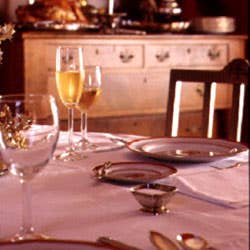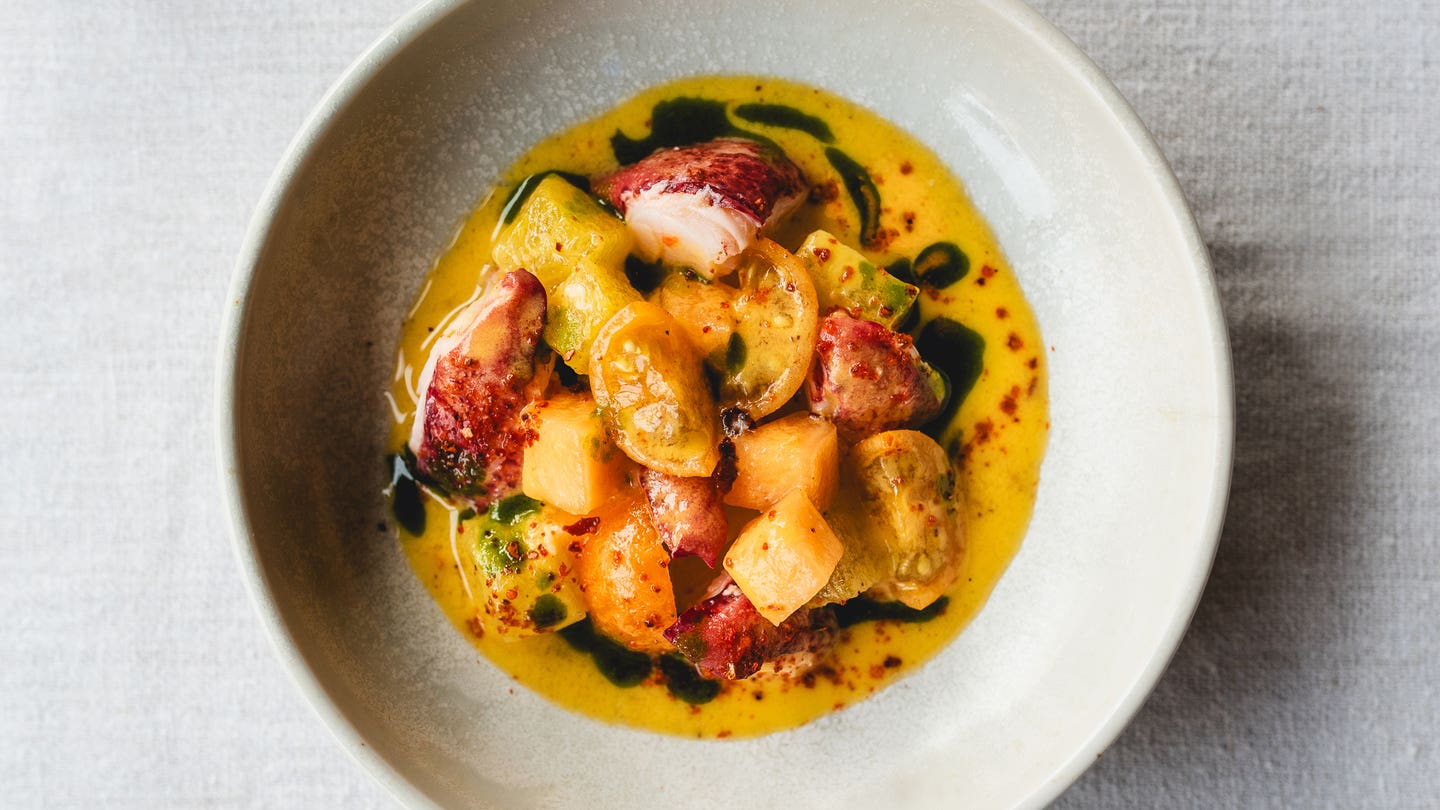
Mother’s Table
At holiday dinners in our flat on Pacific Avenue in San Francisco in the 1950s, my mother would always start nipping at the bourbon. And with good reason, she'd say. She felt perfectly deserving of the extra, fortifying sip because she had, after all, been preparing the holiday meal, and it had left her fit to be tied. She'd set the table well in advance, with the palest gray damask cloth that matched the trim and ceiling of our Chinese-red dining room. The cloth also matched the gray of our fancy Spode china—which had a tiny red schooner, the same color as the walls, anchored in the middle of each plate. This resolutely red-and-gray dining room was always lit for dinner with dozens of candles. The silver had been polished to a fare-thee-well; the three or four glasses at each place had been rubbed to gleam in the candlelight. At the center of the table was a silvery mirror, placed there to look like an icy pond, around which fragile glass reindeer seemed to stoop for a sip of cold water. Miniature snow-dusted trees stood at the corners of the pond, as a pocket-size St. Nick on ice skates glided across its center, with loden-green elves following close behind.
By the time the guests arrived, my mother would have been cooking for days. She always made the hard sauce for the mincemeat pie first—to give the butter a chance to become saturated with alcoholic flavor, she said, but I suspect it was also so that she could justify an 11:00 a.m. swig of bourbon. (When she made nonalcoholic sauces, she never felt the need to start quite so early.)
I stayed close by when she cooked, because I loved the smells and loved the little chores she would assign to me—and because it was a time when my mother was most creative, most absorbed. I'd help mash the sweet potatoes with brown sugar, orange juice, and Myers's rum. I'd lend a hand in making the turkey stuffing, the way her distant relatives did in Mississippi—with corn bread, bacon drippings, and lots of herbs. Aunt Eda, an Italian pianist who lived downstairs—not a relative, but our grandmother's friend—would bring up a plate of pickled pig's feet, much to the amusement of my brother and me (they were far too odd and adventurous for our young palates). She'd usually stick around for a tiny glass of sherry and to chop parsley for my mother's marinated olives. Our Uncle Dudley would inevitably come over a little early to visit his antique guitar and banjo collection, which was stashed in our basement—his hidden assets, he called the instruments, obscured from the accounting eye of his estranged wife. He'd ask my mother if she'd like him to serenade her while she cooked—his favorite tune was "Miss Otis Regrets". But she'd always say, "I have to concentrate, Dud. Maybe a little something classical would be soothing."
Most of the meals my mother prepared were really quite exotic, especially considering the era—certainly more so than a lot of other mothers' attempts to jazz up the bland food of the time. My father was a film and drama critic and my mother was a political activist, and between them they were always bringing home unusual, bohemian recipes—a "Mississippi meatloaf" one day, a "Portuguese bean stew" (made with a whole bottle of ketchup!) the next, Katie's capon from Alice B. Toklas's cookbook the day after that.
I like to think that I've expanded on the family repertoire—that I've picked up where our mother left off when she died back in the 1970s. My mother, for instance, never ate tamales with mole poblano with the Zapotecs of Oaxaca—mole for which my friends and I helped grind the chocolate from beans. She never sampled Masai cornmeal gruel studded with bits of wild kudu in the bush of Kenya as I once did. She never even tried such comparatively tame fare as rice with cuttlefish ink in Barcelona, braised beef cheeks in Paris, or lamb tagine with cardoons in Morocco.
Inevitably, though, I still cook some of the same things that she used to prepare. Getting out her recipe box, hand-painted in cornflower blue and white, I follow the instructions within to make her gazpacho, her taramosalata, her marsala wine jelly—and I have never ever made a holiday dinner yet that wasn't identical to the one that, for 25 years, I stood by her side to help her create.
My mother drummed manners into all of us—my brother and me, our friends, even my father's grown-up colleagues—with the assurance that if we behaved properly, we could venture anywhere in the world with ease and comfort. I remember these supposed social graces, to be sure. Over the years, though, I've veered far from the formidable, formal dinner table settings of my youth. The last necktie worn at one of my dinner parties was in the early days of the Carter administration. There are not always three or four glasses at each place. And I wouldn't dream of ringing a little silver bell for help from the kitchen as she used to do on special occasions.
Over dinner recently, however, one of my oldest friends—who had once uncharitably depicted my mother as "a ferocious woman in a headband and a girdle"—said something that made me wonder whether I'd left the dinner parties of my youth as far behind as I'd imagined. "Do you realize," asked my friend, "that your dining room is exactly like your mother's? These are the same plates we used when we were kids, the room is painted the same Chinese red, even the table and chairs are the same. And aren't these the candlesticks she had me polish a second time one day because Alan Watts was coming for dinner?"
Well, of course I'd known all that—but I'd never really thought about the implications. I'd never really stopped to think that I had inadvertently followed in the steps of a woman with whom, more than 20 years after her death, I had never quite come to terms. Suddenly, unexpectedly, I found myself missing her in the tenderest ways. I longed to discuss recipes and food with her. I wished she had lived to see me writing for exactly the type of periodical that brought her the most pleasure—food magazines, which she invariably pored over (along with cookbooks) at lunch, as she ate her wobbly, homemade tomato aspic or whatever it was that day. It became painful to realize that I could never talk to her again, or cook at her side.
One day, during this stretch of time when I was beginning to reconcile our relationship, I started to look up a simple cooking procedure—how to soak stale bread and reconstitute it for a tomato-and-bread salad—in a book called The Food of Italy⁄How to Prepare It by Edwin H. Knopf and Mildred O. Knopf (Knopf, 1964). As I opened it, I found on the leaf cover, in my mother's scratchy, almost indecipherable scrawl, her technique for the procedure. And at the same moment, I almost felt her breathing down my neck; she was there, in spirit, to answer my question. I recall her explaining why the bread needed to be rehydrated, following an age-old custom from the days when families baked bread only once a week. (After the remains of the fresh bread had gone stale, something had to be done with it to make it palatable, so it would be soaked in liquid and squeezed out, then used in soups and salads.) And I cried over her that day, for the first time in a long while.
All of a sudden I started remembering other things she taught me in the kitchen, like how to make a great summer fruit salad with a minty vinaigrette, or how to roast crispy brown potatoes with a leg of lamb—or how, when all else fails, to consult The Joy of Cooking. That afternoon, I went downstairs to my red dining room. I added the leaves that lengthen the table I inherited from her, to see how many people I could fit around it. I had decided to have a holiday dinner in my mother's honor.
I got out her gray tablecloth and those dinner plates with the tiny red schooners anchored in the middle, and I polished all of her tarnished candlesticks. Nobody was to bring anything—my mother had never allowed that. When my guests had gathered around the table, not only did we toast her—we all felt her presence in the lively conversation, in the colors and mood of the room, in the eclectic mix of people. We felt it in her recipes. It was my best holiday yet.
And as I blew out the candles at the end of the evening, still sensing my mother's spirit, I squinted off into the distant winter sky, trying to figure out who made that little dent in the bottle of bourbon.
Keep Reading
Continue to Next Story










